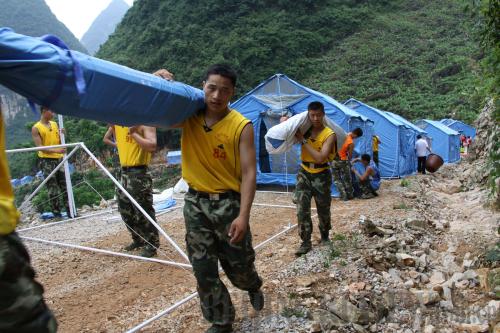|
Bizarre weather
In an interview with the People's Daily, Zhang Zhitong, Deputy Director of Flood Control Headquarters, said there would be six to eight typhoons hitting the mainland this year and warned they may cause even more damage.
Experts say the southern part of the Huaihe River in central China has entered its major flood season, and the northern part of the country will follow suit.
 |
|
A HELPING HAND: Armed police in Guangxi Zhuang Autonomous Region help people of Yao ethnic group build up tents on June 19 for those who lost their homes (XINHUA) | At the outset of the flood season, the middle and lower reaches of the Yangtze River in south China took in more water from the upper reaches than previous years. Meanwhile, the water level at Yangtze River is 1 meter higher than average.
To date, more than 110 rivers have risen above their alert levels. Zhang said it's likely the major rivers of south China will swell to cause massive flooding if the storms continue.
The southwestern part of China suffered from a severe 200-day drought ending in April. The dry weather frizzled the soil, which became less viscous. The stones cracked. After such a long drought, soil and stones can easily be washed away, leading to disastrous mudflows.
Old infrastructure
 |
|
AGAINST ALL ODDS: Students attending the national college entrance examinations in Xupu County of Hunan Province take boats guarded by soldiers to their exam rooms (WANG JIYUN) |
Ever since the founding of the People's Republic of China in 1949, the central and local governments have been striving to build up a concrete fortress to guard against floods and droughts that frequently visit the country.
Huge dams have been built alongside major riverbanks. However, flood control projects in medium- and small-sized rivers are far from sufficient, especially for defense against landslides and mudflows, said Zhang.
Making things worse is a lot of people in rural areas live along mountainsides or at the foot of mountains. Landslides can easily destroy their property no matter how rarely they occur.
| 